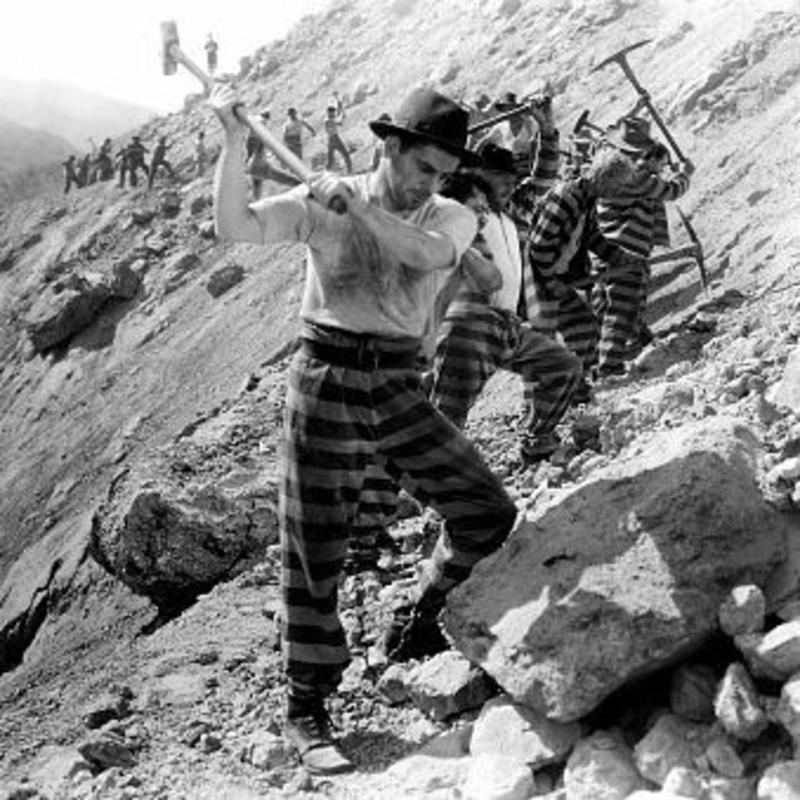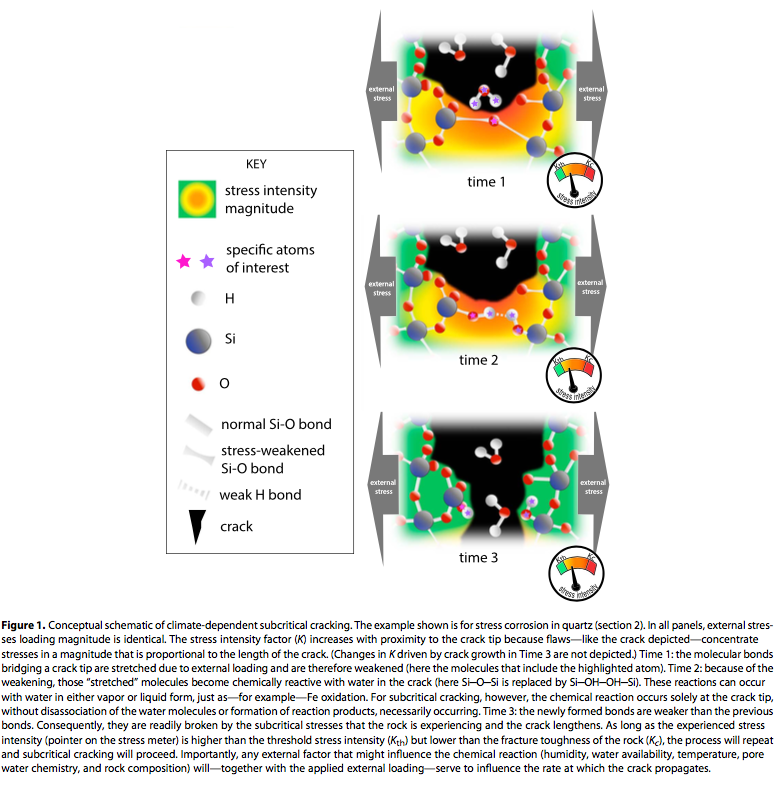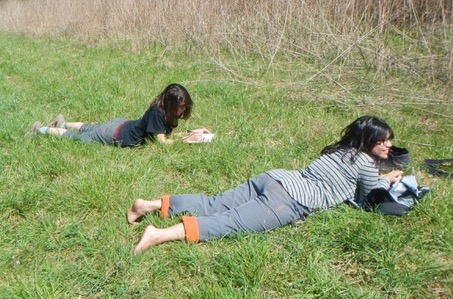Several years back when I was working on the energetics of landscape evolution, focusing on the biological subsidy to geophysical energy sources, I tried to get my head around the energy required to turn fresh rock into transportable debris by weathering. I looked at factors such as the chemical activation energy of rocks, and various strength/stress measures (tensile & compressive strength, etc.). My geochemistry and rock mechanics background is/was too feeble for me to get very far with this beyond drawing two very broad conclusions:
1. It takes a lot of energy to break down rock.
2. There has to be more to it than the basic force/resistance principles (for example shear stress vs. shear strength) that I am familiar with, and that work perfectly well in some contexts.

Breaking rocks the hard way
The answer to item 2 (or at least ananswer) came in the form of the concept of subcriticalstresses and processes. I have not done a deep dive into the origins of these concepts, but arguably the pioneer (and unarguably my gateway to it) is M.-C. “Missy” Eppes. Though she had worked on the concept before, a 2017 article with Russell Keanini introduced me to weathering due to subcritical cracking.
Their analysis of fracture mechanics established that mechanical weathering in most rock types progresses by climate-dependent subcritical cracking under virtually all Earth surface and near-surface environmental conditions. Eppes and Keanini (2017) developed subcritical cracking and rock erosion models based on fracture mechanics and mechanical weathering theory and observations. They showed that subcritical cracking can culminate in significant rock fracture and erosion under commonly experienced environmental stress magnitudes that are significantly lower than rock critical strength.
Eppes and Keanini (2017) were particularly concerned with climate effects, and their results indicate that climate strongly influences subcritical cracking—and thus rock weathering rates—irrespective of the source of the stress (e.g., freezing, thermal cycling, and unloading). The climate dependence of subcritical cracking rates is due to physical and chemical processes acting to break bonds at crack tips experiencing these low stresses. They found that for any stress or combination of stresses lower than a rock’s critical strength, linear increases in humidity lead to exponential acceleration of subcritical cracking and rock erosion.

Figure 1 from Eppes & Keanini (2017)
The take-home message for me was that macro-thresholds (that is, applicable to an entire rock mass or clast) of force-resistance do not have to be exceeded for weathering and erosion to occur. Micro-scale thresholds of bond-breaking in tiny cracks can also get the job done.
In a commentary titled “breaking rocks made easy,” Voigtländer and Krautblatter (2019) related subcritical cracking and stress at the microscale within rocks to the broader scale stress fields associated with tectonics (the tectonic predesign principle pioneered by Adrian Scheidegger). I cannot do a better job than they did in explaining (including a delightful series of cartoons) how concentrations of stress at key points can get erosional work done even when overall force:resistance thresholds (that is, those that can be measured at scales larger than the micro- or nano-scale) are not exceeded. This includes the direction at which force is applied in addition to heterogeneities in the material.


Two of the cartoons from Voigtländer and Krautblatter (2019) using simple analogs.
Tectonic geomorphology and rock mechanics are not my areas of expertise, but in thinking about riverbank erosion processes in my previous post, the general reasoning probably applies to weathering and erosion more general—that is, the important action may occur at very local (subcritical) scales. Erosion resistance can be controlled by, say, the loosest grain or aggregate or the invisible crack in the rock rather than by what could be measured with, for instance, a shear vane or a Schmidt hammer.
This switches my original question from “why are (traditional) force:resistance analyses so often unsatisfactory?” to why they work as well as they do, given the unbiquitous anisotropy and heterogeneity in even the most uniform-appearing Earth materials and the presence of invisible stress fields.
I don’t have even a proposed answer for this at the moment, but it leads me to another analogy: the local nature of efficiency selection. Many flow processes (and other processes, too) are governed by a general principle whereby more efficient flow paths tend to persist and grow, while less efficient ones do not. But flowing or seeping water, growing root tips, creeping soil, etc., can only “see” and react to what is in their immediate vicinity. Thus the most efficient local path may or may not be consistent with the most efficient configuration at the broader scale of a channel or conduit network, root system, or hillslope. Tasnuba Jerin and I presented an example of this in a fluviokarst system (Jerin and Phillips, 2017).

Tasnuba Jerin (front) and Darion Carden contemplating local efficiency selection in a paleochannel of Shawnee Run, Kentucky.
So how can we understand the interactions between these highly localized and broader scale phenomena, be they stress fields or flux efficiencies? I’ll let you know if I think I’ve made any progress in figuring it out.
References
Eppes, M-C., Keanini, R. 2017. Mechanical weathering and rock erosion by climate-dependent subcritical cracking. Reviews of Geophysics5: 470–508, doi:10.1002/2017RG000557.
Jerin, T., Phillips, J.D., 2017. Local efficiency in fluvial systems: Lessons from Icicle Bend. Geomorphology282: 119-130.
Voigtländer, A., Krautblatter, M. 2019. Breaking rocks made easy. Blending stress control concepts to advance geomorphology. Earth Surface Processes & Landforms44: 381-388, doi:10.1002/esp.4506.
Questions/comments: jdp@uky.edu
